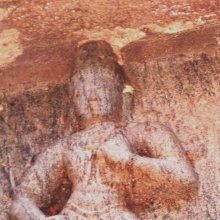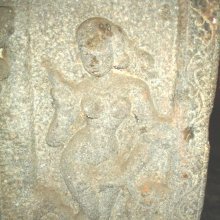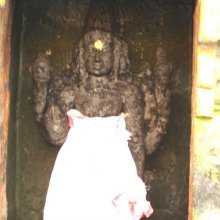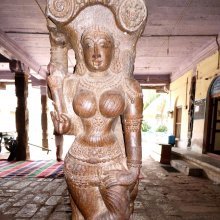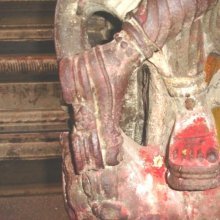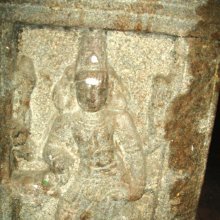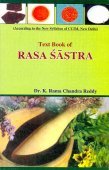Ardhacandra, Ardha-candra, Ardhacamdra: 24 definitions
Introduction:
Ardhacandra means something in Buddhism, Pali, Hinduism, Sanskrit, the history of ancient India, Marathi. If you want to know the exact meaning, history, etymology or English translation of this term then check out the descriptions on this page. Add your comment or reference to a book if you want to contribute to this summary article.
Alternative spellings of this word include Ardhachandra.
Images (photo gallery)
(+14 more images available)
In Hinduism
Natyashastra (theatrics and dramaturgy)
Source: Wisdom Library: Nāṭya-śāstraArdhacandra (अर्धचन्द्र, “crescent moon”) refers to a gesture (āṅgika) made with a ‘single hand’ (asaṃyuta), according to the Nāṭyaśāstra chapter 8. The hands (hasta) form a part of the human body which represents one of the six major limbs (aṅga) used in dramatic performance. With these limbs are made the various gestures (āṅgika), which form a part of the histrionic representation (abhinaya).
(Instructions of Ardhacandra): The fingers and the thumb so bent as to make a curve like a bow.
(Uses of Ardhacandra): With this should be represented young trees, crescent moon, conch shell, jar (kalaśa), bracelet, forcible opening, exertion, thinness and drinking. With this [very] Ardhacandra hand women should represent girdle, hip waist, face, Tālapatra and earring.
Source: archive.org: The mirror of gesture (abhinaya-darpana)One of the Twenty-eight Single Hands (hasta):—Ardha-candra (half-moon): the thumb of the Patāka hand isstretched out. Usage: the moon on the eighth day of the dark fortnight, a hand seizing the throat, a spear, consecrating animage, a platter, origin, waist, anxiety, one’s self, meditation,prayer, touching the limbs, greeting common people.
Note: This hand often replaces the Patāka, e.g., in the Abhaya-mudrā.
According to another book: same definition. This hand originatesfrom the desire of Śiva for ornaments, of which the moonis one. Its sage is Atri, its race Vaiṣya, its colour smoky, itspatron deity Mahādeva. Usage: bangle, wrist, mirror, astonishment, effort, intemperance, entirety, beating time, tying up the hair, supporting the cheek in grief, the ear of an elephant, expelling evil-doers, wiping sweat from the brow, adolescence, ability, moon, greeting common people, consecration, eyebrow, cloth, bow, preëminence, tightening the girdle, making a vessel, the body, movement of the feet, carrying a child, the back, white colour, Vaiṣya caste.
Source: Shodhganga: Elements of Art and Architecture in the Trtiyakhanda of the Visnudharmottarapurana (natya)Ardhacandra (अर्धचन्द्र) refers to one of the twenty-two Asaṃyuktahastas or “single hand gestures” (in Indian Dramas), according to the Viṣṇudharmottarapurāṇa, an ancient Sanskrit text which (being encyclopedic in nature) deals with a variety of cultural topics such as arts, architecture, music, grammar and astronomy.—The hasta-mudrās (lit. “hand-gestures”) are very essential to denote some particular action or state in dancing and these mudrās are formed with the help of hands and fingers.—The derivation of the word ardhacandra is found in the Śabdakalpadruma as—“ardhaṃ candrasya, candrakhaṇḍaṃ” which means “half of the moon”. The Viṣṇudharmottarapurāṇa suggests that in ardhacandra-hasta, the ring finger touches the thumb. But according to the Abhinayadarpaṇa, if the bent thumb of patāka hand is stretched out, it is called ardhacandra-hasta. It is important to note here that, patāka hand with strengthened thumb looks like a half moon which justifies the present hastamudrā called ardhacandra. But ardhacandra hand, as narrated in the Viṣṇudharmottarapurāṇa, does not identify the hand posture which denotes half moon. In spite of it, the posture of ardhacandra-hasta, as stated in the Viṣṇudharmottarapurāṇa is similar with the mayura-hasta as found in the Abhinayadarpaṇa. According to the Viṣṇudharmottarapurāṇa, the ardhacandra-hasta is used to show growing moon. Moreover, it also identifies a child, a tree named Tāla, the waist part of a person etc. The acting of putting ear-rings is also showed with this hastamudrā

Natyashastra (नाट्यशास्त्र, nāṭyaśāstra) refers to both the ancient Indian tradition (shastra) of performing arts, (natya—theatrics, drama, dance, music), as well as the name of a Sanskrit work dealing with these subjects. It also teaches the rules for composing Dramatic plays (nataka), construction and performance of Theater, and Poetic works (kavya).
Ayurveda (science of life)
Rasashastra (Alchemy and Herbo-Mineral preparations)
Source: Wisdom Library: Rasa-śāstraArdhacandrā (अर्धचन्द्रा):—One of the sixty-eight Rasauṣadhi, very powerful drugs known to be useful in alchemical processes related to mercury (rasa), according to Rasaprakāśa-sudhākara (chapter 9).

Āyurveda (आयुर्वेद, ayurveda) is a branch of Indian science dealing with medicine, herbalism, taxology, anatomy, surgery, alchemy and related topics. Traditional practice of Āyurveda in ancient India dates back to at least the first millenium BC. Literature is commonly written in Sanskrit using various poetic metres.
Shilpashastra (iconography)
Source: Shodhganga: The significance of the mūla-beras (śilpa)Ardhacandra (अर्धचन्द्र) or Ardhacandrahasta refers to “half moon” and represents one of the twenty-four gestures with a single hand, as defined according to texts dealing with śilpa (arts and crafs), known as śilpaśāstras.—Accordingly, pratimā-lakṣaṇa (body postures of the icons) is comprised of hand gestures (hasta, mudrā or kai-amaiti), stances/poses (āsanas) and inflexions of the body (bhaṅgas). There are thirty-two types of hands [viz., ardhacandra-hasta] classified into two major groups known as tolirkai (functional and expressive gestures) and elirkai (graceful posture of the hand).

Shilpashastra (शिल्पशास्त्र, śilpaśāstra) represents the ancient Indian science (shastra) of creative arts (shilpa) such as sculpture, iconography and painting. Closely related to Vastushastra (architecture), they often share the same literature.
Shaktism (Shakta philosophy)
Source: Google Books: ManthanabhairavatantramArdhacandra (अर्धचन्द्र, “half-moon”) refers to one of the seventeen stages of the rise of kuṇḍalinī, according to Abhinavagupta as drawn from the Devyāyāmala.—Cf. The seventeen syllables [i.e., saptadaśākṣara] of Mantramātā.—[...] These seventeen units [are] to be arranged in as many locations along the axis of the subtle body, [as was] clearly known to Abhinava. Thus he presents an ascending series marking the stages of the rise of Kuṇḍalinī, the highest stage of which is that of the ‘Pure Self’ heralded by the Transmental just below it. In this set-up, drawn by Abhinavagupta from the Devyāyāmala, there are seventeen stages. These are [e.g., the Half Moon (ardhacandra), ...].
Jayaratha quotes this [Devyāyāmala] Tantra as a source of [Kālasaṃkarṣiṇī’s] Vidyā consisting of seventeen syllables. As the Devyāyāmala tells us that these places are related to the recitation of mantra, we may conclude that the seventeen syllables are contemplated in these seventeen places [e.g., Half Moon (ardhacandra)]. Accordingly, the Wheel of the Self can be said to be at the end of (i.e. after) the sixteen [i.e., ṣoḍaśānta].

Shakta (शाक्त, śākta) or Shaktism (śāktism) represents a tradition of Hinduism where the Goddess (Devi) is revered and worshipped. Shakta literature includes a range of scriptures, including various Agamas and Tantras, although its roots may be traced back to the Vedas.
Purana and Itihasa (epic history)
Source: archive.org: Puranic EncyclopediaArdhacandra (अर्धचन्द्र) or Ardhacandravyūha refers to the “Disposition of an army like a Crescent moon”.—Disposition of an army (vyūha) of four parts, (infantry, cavalry, elephants and chariots) in the battlefield, the arrangement of it, in various forms. It is said that during the period of Mahābhārata, there were various forms of disposition of the army.—Ardhacandra-vyūha is mentioned in the Mahābhārata Bhīṣma Parva, Chapter 56.

The Purana (पुराण, purāṇas) refers to Sanskrit literature preserving ancient India’s vast cultural history, including historical legends, religious ceremonies, various arts and sciences. The eighteen mahapuranas total over 400,000 shlokas (metrical couplets) and date to at least several centuries BCE.
Shaivism (Shaiva philosophy)
Source: SOAS University of London: Protective Rites in the Netra TantraArdhacandra (अर्धचन्द्र) refers to a “half-moon”, according to the Netratantra of Kṣemarāja: a Śaiva text from the 9th century in which Śiva (Bhairava) teaches Pārvatī topics such as metaphysics, cosmology, and soteriology.—Accordingly, [verse 11.1-24ab, while describing the appearance and worship of Tumburu]—“[...] [He worships] Deva as Tumburu in the middle of an eight petaled lotus, in the maṇḍala, [starting] in the East, O Devī. [...] He [has] a half-moon in his topknot (ardhacandra-śiras—taṃ cārdhacandraśirasaṃ), sits in the blue lotus āsana. [Tumburu is] white like a drop of frosty jasmine, similar to mountain snow. [He wears] a serpent as a sacred thread and is adorned with snake ornaments. [Tumburu is] adorned with all jewels, a tiger skin on the ground [below his] hips, a garment of elephant skin, mounted on a very strong bull, and wears a rhino hide. [...]”.

Shaiva (शैव, śaiva) or Shaivism (śaivism) represents a tradition of Hinduism worshiping Shiva as the supreme being. Closely related to Shaktism, Shaiva literature includes a range of scriptures, including Tantras, while the root of this tradition may be traced back to the ancient Vedas.
In Buddhism
Mahayana (major branch of Buddhism)
Source: academia.edu: A Study and Translation of the Gaganagañjaparipṛcchā1) Ardhacandra (अर्धचन्द्र) refers to a type of jewel or precious stone, according to the Gaganagañjaparipṛcchā: the eighth chapter of the Mahāsaṃnipāta (a collection of Mahāyāna Buddhist Sūtras).—Accordingly: “[...] Then the Bodhisattva Ratnavyūha said to the Bodhisattva Gaganagañja: ‘Son of good family, please pour down rain of all kinds of jewels from the sky’. Immediately after his words, the great rain of immeasurable, incalculable amount of jewels, equal to Mount Sumeru in size, with various kinds of names and colors, poured down from ten directions. To wit, [...] blazing light gem, the victor’s essence of glory gem, adamantine gem, worldly light gem, Jyotīrasa gem, shining gem, Ardhacandra gem, Jambū-water-light gem, Jambūdvīpa-light gem, thousand lights gem, shooting star gem, burning light gem, [...]”.
2) Ardhacandra (अर्धचन्द्र) refers to “half-moon shaped decorations (on building)”, according to the Gaganagañjaparipṛcchā.—Accordingly: “Then the Bodhisattva Apāyajaha addressed himself to the Bodhisattva Gaganagañja: ‘Son of good family, please pacify three evil existences’. [...] Then, the rain of gifts, such as [...] chariots, foot-soldiers, vehicles, houses, villages, cities, towns, provinces, kingdoms, capitals, gardens, pavilions, palaces, portals, windows, half-moon shaped decorations on building (ardhacandra), thrones, palanquin, and chariots drawn by four cattle, sixteen cattle, and a thousand of good horses, poured down from the open space. [...]”.

Mahayana (महायान, mahāyāna) is a major branch of Buddhism focusing on the path of a Bodhisattva (spiritual aspirants/ enlightened beings). Extant literature is vast and primarely composed in the Sanskrit language. There are many sūtras of which some of the earliest are the various Prajñāpāramitā sūtras.
Tibetan Buddhism (Vajrayana or tantric Buddhism)
Source: OSU Press: Cakrasamvara SamadhiArdhacandra (अर्धचन्द्र) refers to “(possesing) a crescent moon” which is used to describe Cakrasaṃvara, according to the Saṃvaramaṇḍala of Abhayākaragupta’s Niṣpannayogāvalī, p. 45 and n. 145; (Cf. Cakrasaṃvaratantra, Gray, David B., 2007).—Accordingly, [while describing the iconography of Cakrasaṃvara]: “In the Saṃvara Maṇḍala atop Mount Sumera within a vajra-canopy there is a variegated lotus, on top of that a palace, in the middle of which is the Blessed Lord, standing in ālīḍhāsana, "archer's pose", [...] possessing a naraśiromālā-śatārdha, "garland of fifty (fresh) human heads" around the neck, the ṣaṇmudrā, "six insignia", bone ornaments, which are the kaṇṭhikā, "necklace", rucaka, "bracelets", kuṇḍala, "ear-rings", mekhalā, "girdle", śiromaṇi, "crest jewel", and bhasmitiḥ, "covered in ashes", a jaṭāmakuṭa, "crest of dreadlocks", kapālamālā, "crown of (five) skulls", topped by an ardhacandra, "crescent moon", and viśvavajra, "world vajra" or "double vajra", a vikṛitānana, "fierce face", and daṃṣṭrotkaṭa, "horrible gigantic fangs".
Note: The crescent moon (ardhacandra) symbolizes the phases of the moon as representing the stages of the Bodhisattva Path (bhūmis).
Source: MDPI Books: The Ocean of HeroesArdhacandra (अर्धचन्द्र) refers to the “crescent moon”, according to the 10th-century Ḍākārṇava-tantra: one of the last Tibetan Tantric scriptures belonging to the Buddhist Saṃvara tradition consisting of 51 chapters.—Accordingly, “[...] [The Causal Vajra-holder] is white in color, [has] four faces, [has] three eyes [on each], [has] twelve arms, is devoted to the yoga of union with wisdom (his female consort), and is adorned with youthful ornaments. [His four faces are], counterclockwise, white, green, red, and yellow [in color, respectively]. [He has] twisted locks of hair and has a crossed Vajra and a crescent moon (ardhacandra-dhṛk) on the face (head). [...]”.

Tibetan Buddhism includes schools such as Nyingma, Kadampa, Kagyu and Gelug. Their primary canon of literature is divided in two broad categories: The Kangyur, which consists of Buddha’s words, and the Tengyur, which includes commentaries from various sources. Esotericism and tantra techniques (vajrayāna) are collected indepently.
India history and geography
Source: Cologne Digital Sanskrit Dictionaries: Indian Epigraphical GlossaryArdha-candra.—(SITI), literally, ‘half-moon’; a part of the tiruvāśi; a variety of ornament. (SII 2), the arch of an aureola. Note: ardha-candra is defined in the “Indian epigraphical glossary” as it can be found on ancient inscriptions commonly written in Sanskrit, Prakrit or Dravidian languages.

The history of India traces the identification of countries, villages, towns and other regions of India, as well as mythology, zoology, royal dynasties, rulers, tribes, local festivities and traditions and regional languages. Ancient India enjoyed religious freedom and encourages the path of Dharma, a concept common to Buddhism, Hinduism, and Jainism.
Languages of India and abroad
Marathi-English dictionary
Source: DDSA: The Molesworth Marathi and English Dictionaryardhacandra (अर्धचंद्र).—m (S) The moon in her half increase or decrease, half-moon. 2 fig. The hand curved semicircularly, as for the purpose of clutching. 3 A clutch by the neck and push. v dē 4 A semicircular object or appearance gen.
Source: DDSA: The Aryabhusan school dictionary, Marathi-Englishardhacandra (अर्धचंद्र).—m The half-moon, crescent moon. The hand bent into a semi-circle, for the purpose of seizing or clutching anything. ardhacandra dēṇēṃ To seize by the neck and turn out.
Marathi is an Indo-European language having over 70 million native speakers people in (predominantly) Maharashtra India. Marathi, like many other Indo-Aryan languages, evolved from early forms of Prakrit, which itself is a subset of Sanskrit, one of the most ancient languages of the world.
Sanskrit dictionary
Source: DDSA: The practical Sanskrit-English dictionaryArdhacandra (अर्धचन्द्र).—a. crescent-shaped.
-ndraḥ
Ardhacandra is a Sanskrit compound consisting of the terms ardha and candra (चन्द्र).
Source: Cologne Digital Sanskrit Dictionaries: Edgerton Buddhist Hybrid Sanskrit DictionaryArdhacandra (अर्धचन्द्र).—m. (? or nt.; in Sanskrit half-moon, crescent, etc.), (1) a kind of (presumably crescent-shaped) personal ornament (also °draka, q.v.): Lalitavistara 201.19; Mahāvastu ii.317.7 (here hung on the bodhi-tree); (2) as in Sanskrit according to Schmidt, Nachtr., s.v., from Haravijaya, a (crescent-shaped) de- coration on a building (Schmidt Torbogenschmuck): Gaṇḍavyūha 167.16 °drā(ḥ), n. pl.; 154.4, 202.23 (all prose).
Source: Cologne Digital Sanskrit Dictionaries: Shabda-Sagara Sanskrit-English DictionaryArdhacandra (अर्धचन्द्र) or Arddhacandra.—m.
(-ndraḥ) 1. A crescent or half moon. 2. The hand bent into a semicircle or the shape of a claw, as for the purpose of seizing or clutching any thing. 3. The semicircular marks on a peacock’s tail. 4. An arrow, with a head like a crescent. 5. The semicircular scratch of the finger nail. f.
(-ndrā) A plant, vulgarly Teori, the black kind. E. ardha half, and candra moon, or with kan added ardhacandrakaḥ.
Source: Cologne Digital Sanskrit Dictionaries: Benfey Sanskrit-English DictionaryArdhacandra (अर्धचन्द्र).—[ardha-candra], m. 1. A half-moon, [Rāmāyaṇa] 3, 49, 35.
— Cf. ardha -bhāṣara. 2. An arrow with a head like a half-moon, [Rāmāyaṇa] 3, 34, 30; cf. 6, 36, 77. 3. The hand bent into a semicircle or the shape of a claw, as for the purpose of seizing or clutching any thing. ardhacandraṃ dā. To seize one by the neck, [Pañcatantra] 63, 24.
--- OR ---
Ardhacandra (अर्धचन्द्र).—see separately.
Ardhacandra is a Sanskrit compound consisting of the terms ardha and candra (चन्द्र).
Source: Cologne Digital Sanskrit Dictionaries: Cappeller Sanskrit-English DictionaryArdhacandra (अर्धचन्द्र).—[masculine] half-moon, crescent.
Source: Cologne Digital Sanskrit Dictionaries: Monier-Williams Sanskrit-English Dictionary1) Ardhacandra (अर्धचन्द्र):—[=ardha-candra] m. half moon
2) [v.s. ...] the semi circular marks on a peacock’s tail, [cf. Lexicographers, esp. such as amarasiṃha, halāyudha, hemacandra, etc.]
3) [v.s. ...] the semicircular scratch of the finger nail, [cf. Lexicographers, esp. such as amarasiṃha, halāyudha, hemacandra, etc.]
4) [v.s. ...] an arrow, the head of which is like a half-moon, [Mahābhārata; Rāmāyaṇa; Kathāsaritsāgara] (cf. ardhacandra-mukha and ardha candrāpama below)
5) [v.s. ...] the hand bent into a semicircle or the shape of a claw (as for the purpose of seizing anybody by the neck; generally [accusative] am with √1. dā, to seize any one by his neck), [Kathāsaritsāgara; Pañcatantra; Vetāla-pañcaviṃśatikā]
6) [v.s. ...] Name of the Anusvāra (from its being written in the older [manuscripts] in a semilunar form), [Rāmatāpanīya-upaniṣad]
7) [v.s. ...] Name of a constellation, [Varāha-mihira’s Bṛhat-saṃhitā]
8) Ardhacandrā (अर्धचन्द्रा):—[=ardha-candrā] [from ardha-candra] f. the plant Convolvulus Torpethum
9) Ardhacandra (अर्धचन्द्र):—[=ardha-candra] mfn. crescent shaped, of a semilunar form, [Hemādri’s Caturvarga-cintāmaṇi]
[Sanskrit to German]
Sanskrit, also spelled संस्कृतम् (saṃskṛtam), is an ancient language of India commonly seen as the grandmother of the Indo-European language family (even English!). Closely allied with Prakrit and Pali, Sanskrit is more exhaustive in both grammar and terms and has the most extensive collection of literature in the world, greatly surpassing its sister-languages Greek and Latin.
Kannada-English dictionary
Source: Alar: Kannada-English corpusArdhacaṃdra (ಅರ್ಧಚಂದ್ರ):—
1) [noun] = ಅರ್ಧಚಂದ್ರಯೋಗ [ardhacamdrayoga].
2) [noun] the moon in a phase, when it appears to have one concave edge and one convex edge just after new moon (waxing crescent) or just before new moon (waning crescent); the crescent moon.
3) [noun] an arrow with crescent shaped head.
4) [noun] (dance) a single hand-gesture with fingers extended close to each others, thumb stretched away, as to form the shape of a crescent, as if to seizing or clutching anything.
5) [noun] a pushing out of a person holding his nape.
6) [noun] (fig.) the act or an instance of removing or ousting a person unceremoniously.
7) [noun] the semicircular mark on a peacock’s tail.
Kannada is a Dravidian language (as opposed to the Indo-European language family) mainly spoken in the southwestern region of India.
Nepali dictionary
Source: unoes: Nepali-English DictionaryArdhacandra (अर्धचन्द्र):—n. half-moon; a crescent; the marking on the peacock's tail;
Nepali is the primary language of the Nepalese people counting almost 20 million native speakers. The country of Nepal is situated in the Himalaya mountain range to the north of India.
See also (Relevant definitions)
Partial matches: Ardha, Candra.
Starts with (+1): Ardhacamdracuda, Ardhacamdradhvaja, Ardhacamdraprasava, Ardhacamdraprayoga, Ardhacamdrayoga, Ardhacandra Hasta, Ardhacandrabhagin, Ardhacandradharin, Ardhacandradhrik, Ardhacandrahasta, Ardhacandraka, Ardhacandrakara, Ardhacandrakrita, Ardhacandrakriti, Ardhacandrakunda, Ardhacandramukha, Ardhacandrapura, Ardhacandrardhabhaskara, Ardhacandrasana, Ardhacandrashiras.
Ends with: Sardhacandra.
Full-text (+64): Ardhendu, Ardhacandraka, Ardhacandrakara, Ardhacandrabhagin, Angulitorana, Ardhacandrakunda, Palasha, Shimshapa, Ardhacandrakrita, Cakra, Garuda, Karkareta, Shivalinga, Gandabherunda, Bhagiratha, Ardhacandropama, Garudapaksha, Ardhacandrahasta, Ardhacandrakriti, Ardhacamdra.
Relevant text
Search found 21 books and stories containing Ardhacandra, Ardha-candra, Ardhacandrā, Ardha-candrā, Ardhacamdra, Ardhacaṃdra; (plurals include: Ardhacandras, candras, Ardhacandrās, candrās, Ardhacamdras, Ardhacaṃdras). You can also click to the full overview containing English textual excerpts. Below are direct links for the most relevant articles:
Chaitanya Bhagavata (by Bhumipati Dāsa)
Verse 1.15.143 < [Chapter 15 - Marriage with Śrī Viṣṇupriyā]
Abhinaya-darpana (English) (by Ananda Coomaraswamy)
Shat-cakra-nirupana (the six bodily centres) (by Arthur Avalon)
Summary of the Ājñā Cakra (verses 31a-38) < [Section 6]
Nitiprakasika (Critical Analysis) (by S. Anusha)
Cidgaganacandrika (study) (by S. Mahalakshmi)
Forms of Praṇava < [Chapter 4 - Fourth Vimarśa]
Verse 183 [Cidānandamayī Śakti enfolds the projection in one’s Self] < [Chapter 4 - Fourth Vimarśa]
Verse 124 [Vṛnda-krama and Mudrāpañcaka] < [Chapter 3 - Third Vimarśa]
Puranic encyclopaedia (by Vettam Mani)
Related products
